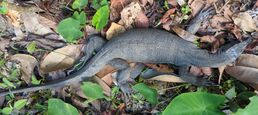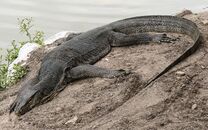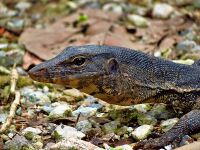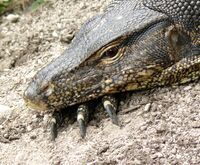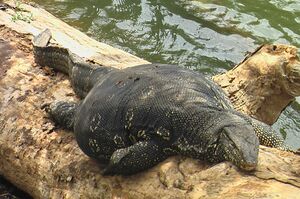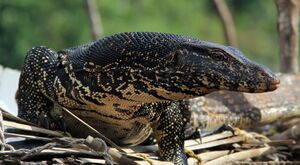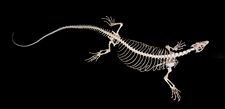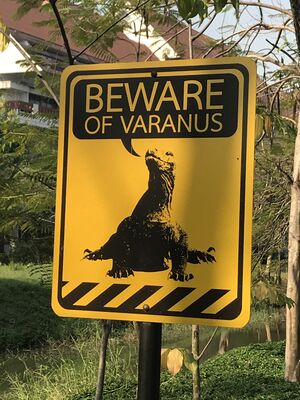ورل الماء الآسيوي
| Asian water monitor | |
|---|---|
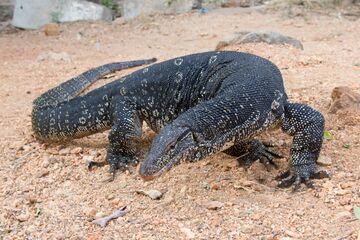
| |
| V. s. salvator | |
| التصنيف العلمي | |
| أصنوفة غير معروفة (أصلحها): | Varanus (Soterosaurus) |
| Species: | Template:Taxonomy/VaranusV. salvator
|
| Binomial name | |
| Template:Taxonomy/VaranusVaranus salvator (Laurenti, 1768)
| |
ورل الماء الآسيوي
ورل الماء الآسيوي (Varanus salvator) هو سحلية من فصيلة الورليات، موطنه جنوب وجنوب شرق آسيا. هو واحد من أكثر الورل شيوعًا في آسيا، بدءًا من سريلانكا وشرق الهند الساحلية إلى الهند الصينية وشبه جزيرة الملايو والجزر الإندونيسية حيث يعيش بالقرب من الماء. تم إدراجه على أنه غير مهدد في القائمة الحمراء للأنواع المهددة بالانقراض. تم وصفه من قبل جوزيفوس نيكولاوس لورنتي في عام 1768، وهو من بين أكبر الحرشفيات في العالم.
يُطلق على ورل الماء الآسيوي أيضًا اسم ورل مياه ملايو، وورل الماء الشائعة، وسحلية الأرز، والسحلية الحلقية، والسحلية التي لا تترك علامات، وورل الماء, التنين الأسود.
( Asian water monitor ؛ واسمه العلمي Varanus salvator) هو سحلية varanid كبيرة موطنها جنوب وجنوب شرق آسيا. It is widely considered to be the second-largest lizard species, after the Komodo dragon. It is distributed from eastern and northeastern India and Bangladesh, the Andaman and Nicobar Islands, Sri Lanka, through southern China and Hainan Island in the east to mainland Southeast Asia and the islands of Sumatra, Borneo, Java, Lombok, the Riau Archipelago, Sulawesi. It is one of the most widespread monitor lizards.
The Asian water monitor has a natural affinity towards water, inhabiting the surroundings of lakes, rivers, ponds, swamps and various riparian habitats, including sewers, city parks, and urban waterways. It is an excellent swimmer and hunts fish, frogs, invertebrates, water birds, and other types of aquatic and amphibious prey. Due to its apparently large, stable population, it is currently listed as Least Concern on to the IUCN Red List.
أصل الاسم
الاسم العام هو (Varanus)، مشتق من الكلمة العربية (ورل). الاسم المحدد هو الكلمة اللاتينية التي تعني «المنقذ»، مما يشير إلى دلالة دينية محتملة. أحيانًا يتم الخلط بين ورل الماء والورل السالفادوري (V. salvadorii) بسبب تشابه اسميهما العلميين.
في تايلاند، الكلمة المحلية لورل الماء هي (เหี้ย)، وتستخدم ككلمة مهينة للأشياء السيئة والشر، بما في ذلك الأشرار. يُعتقد أيضًا أن الكلمة تجلب الحظ السيئ، لذلك يفضل بعض الناس تسمية الحيوانات بـ " الفضة والذهب '' (ตัวเงินตัวทอง) لتجنب النحس. يمكن إرجاع أصل هذا المعنى العدواني إلى وقت كان فيه عدد كبير من الناس يعيشون في المناطق الريفية على مقربة من السحالي. يعيش القرويون التايلانديون في منازل من طابقين؛ كان الطابق العلوي مخصصًا للعيش، بينما تم تصميم الطابق الأرضي ليكون مكانًا للحيوانات الأليفة مثل الخنازير والدجاج والكلاب. كان ورل الماء الآسيوي يدخل إلى الطابق الأرضي لأكل الحيوانات الأليفة أو مُهاجمتها، ومن هنا جاء الاسم الآخر (ตัวกินไก่) " آكل الدجاج "، أو (น้องจระเข้) "التمساح الصغير"، كما يُطلق عليه أحيانًا اسم (ตะกวด)، والذي يشير في الواقع إلى الورل البنغالي، وهو نوع مختلف.
في الإندونيسية والملايوية، يُطلق على ورل الماء الآسيوي اسم (biawak air).
الاسم المحلي في سريلانكا هو (kabaragoya)، وهو يشير إلى نوع فرعي بسمات مورفولوجية مميزة.
The generic name Varanus is derived from the Arabic waral (ورل), which translates as "monitor". The specific name is the Latin word for "saviour", denoting a possible religious connotation.[2] The water monitor is occasionally confused with the crocodile monitor (V. salvadorii) because of their similar scientific names.[3]
Some common names for the species are Malayan water monitor, common water monitor, two-banded monitor, rice lizard, ring lizard, plain lizard, no-mark lizard and water monitor etc.
التصنيف
(Stellio salvator) هو الاسم العلمي الذي استخدمه جوزيفوس نيكولاوس لورنتي في عام 1768 لورل الماء الآسيوي.
تحتوي عائلة (Varanidae) على ما يقرب من 80 نوعًا من جنس الورل، وكلها تنتمي إلى جنس (Varanus).
نوع فرعي
- (V. s. salvator)، ورل الماء الآسيوي، هو نويع، يوجد فقط في سريلانكا، حيث يُعرف باسم (කබරගොයා) في اللغة السنهالية، و (kalawathan) في اللغة التاميلية.
- (V. s. andamanensis)، ورل الماء في جزر أندامان، يسكن في جزر أندامان وجزر نيكوبار الجنوبية. منطقة النوع (type locality) هي بورت بلير.
- (V. s. bivittatus)، ورل الماء ذو الخطين، شائع في جاوة وبالي ولومبوك وسومباوا وفلوريس وألور وويتار، وبعض الجزر المجاورة داخل أرخبيل سوندا في إندونيسيا؛ منطقة النوع هي جاوة.
- (V. s. macromaculatus)، ورل الماء في جنوب شرق آسيا، موجود في البر الرئيسي لجنوب شرق آسيا، وسنغافورة، وسومطرة وبورنيو، والجزر البحرية الأصغر المرتبطة بها. تم التقاط عينة النوع في تايلاند.
- (V. s. ziegleri)، ورل الماء زيغلر، يقع في جزيرة أوبيرا.
وصلة=https://ar.wikipedia.org/wiki/%D9%85%D9%84%D9%81:Monitor_lizard_-_Pulau_Sapi_-_Sabah_-_Borneo_-_Malaysia_-_panoramio.jpg|تصغير كانت (Varanus cumingi) و (Varanus marmoratus) و (Varanus nuchalis) مُصنّفة على أنها سلالات فرعية حتى عام 2007، عندما تم رفعها إلى الأنواع الكاملة.
ورل الماء السوداء من تايلاند كان في السابق السلالات الفرعية (V. s. komaini)، ولكن الآن الصّنف مسود الجلد لـ (V. s. macromaculatus). يُعرف باسم «التنين الأسود» أو «مراقب الماء الأسود» (มังกร ดำ، เหี้ย ดำ) باللغة التايلاندية
Stellio salvator was the scientific name used by Josephus Nicolaus Laurenti in 1768 when he described a water monitor specimen.[4]
The family Varanidae contains nearly 80 species of monitor lizards, all of which belong to the genus Varanus.[5] There is a significant amount of taxonomic uncertainty within this species complex. Morphological analyses have begun to unravel this taxonomic uncertainty but molecular studies are needed to test and confirm the validity of certain groupings within this genus. Research initiatives such as these are very important to assess changes in conservation assessments.[1]
الأنواع الفرعية
- V. s. salvator is the nominate subspecies and is restricted to Sri Lanka.[بحاجة لمصدر]
- V. s. andamanensis, the Andaman Islands water monitor, inhabits the Andaman Islands and the southern Nicobar Islands;[6] the type locality is Port Blair.[بحاجة لمصدر]
- V. s. bivittatus (Mertens 1959), the two-striped water monitor, is common to the Indonesian islands of Java, Bali, Lombok, Sumbawa, Flores, Alor, Wetar and some neighbouring islands within the Sunda archipelago. The type locality is Java.[بحاجة لمصدر]
- V. s. macromaculatus, the Southeast Asian water monitor, occurs from Bihar, West Bengal to Assam, Arunachal Pradesh, Manipur and Meghalaya through Bangladesh, Myanmar, Thailand, Cambodia, Laos, Vietnam to Malaysia, Singapore, Sumatra, Borneo, Bali, Bangka, Batam, Belitung, Bintan, Enggano, Matak, Nikoi. The type specimen was captured in Thailand.[7]
- V. s. ziegleri, Ziegler's water monitor, occurs on the Obi Islands, North Maluku, Indonesia.
- V. s. celebensis, the Sulawesi water monitor, occurs primarily in North Sulawesi Province of the island of Sulawesi, Indonesia.[8]
- Varanus cumingi, Varanus marmoratus, and Varanus nuchalis were classified as subspecies until 2007, when they were elevated to full species.[7]
The black water monitor from Thailand's Satun Province and Thai-Malaysian border area was formerly the subspecies V. s. komaini, but now is regarded as a junior synonym and melanistic population of V. s. macromaculatus.[7]
الوصف
ورل الماء هو نوع كبير من الورل. يتم بلوغ مرحلة النضج عند الذكور عندما يصل إلى 40 سنتيمتر (16 بوصة) في الطول، و1 كيلوغرام (2.2 رطل) في الوزن، وعند الإناث عند طول 50 سنتيمتر (20 بوصة). ومع ذلك، فإنها تنمو بشكل أكبر طوال الحياة، ويكون الذكور أكبر من الإناث. نادرًا ما يتجاوز البالغون من ورل الماء 1.5–2 متر (4.9–6.6 قدم) في الطول، ولكن أكبر عينة مسجلة من سريلانكا، بلغت 3.21 متر (10.5 قدم). يمكن أن يكون الوزن الناضج الشائع لـ (V. salvator) هو 19.5 كيلوغرام (43 رطل).
يبلغ الوزن الأقصى 50 كيلوغرام (110 رطل). في حالات استثنائية، تم الإبلاغ عن أوزان تتراوح من 75 إلى 90 كيلوغرام (165 إلى 198 رطل)، على الرغم من أن معظم هذه التقارير لم يتم التحقق منها وقد تكون غير موثوقة. هي ثاني أثقل سحلية في العالم بعد تنين كومودو. أجسامها عضلية وذات ذيول طويلة وقوية ومضغوطة جانبياً. المقاييس في هذا النوع منقلبة؛ وقد لوحظ أن الحراشف الموجودة أعلى الرأس أكبر من تلك الموجودة على الظهر. غالبًا ما يتم تحديد ورل الماء من خلال لونه البني الغامق أو الأسود مع وجود بقع صفراء على الجانب السفلي له - هذه العلامات الصفراء تميل إلى الاختفاء تدريجياً مع تقدم العمر. يُشار إلى هذا النوع أيضًا بشريط أسود مع حواف صفراء تمتد للخلف من كل عين. هذه الشاشات لها أعناق طويلة وأنف ممدود. يستخدم فكّهُ القوية وأسنانه المسننة ومخالبه الحادة للافتراس والدفاع. في الأسْر، تم تحديد متوسط العمر المتوقع لورل الماء الآسيوية في أي مكان بين 11-25 عامًا حسب الظروف، أما في البرية فيكون أقصر بكثير.
The Asian water monitor is dark brown or blackish with yellow spots on the underside that fade gradually with age. It has blackish bands with yellow edges extending back from each eye. Its body is muscular, with long, powerful, laterally compressed tails. Its scales are keeled; the ones on top of the head are larger than those on the back. Its neck is long and the snout elongated. It has powerful jaws, serrated teeth and sharp claws.[9]
Adults rarely exceed 1.5–2 m (4 ft 11 in – 6 ft 7 in) in length, but the largest specimen on record from Sri Lanka measured 3.21 m (10.5 ft). A common mature weight is 19.5 kg (43 lb).[9] However, 80 males killed for the leather trade in Sumatra averaged only 3.42 kg (7.5 lb) and 56.6 cm (22.3 in) snout-to-vent and 142 cm (56 in) in total length; 42 females averaged 3.52 kg (7.8 lb) and 59 cm (23 in) snout–vent length and 149.6 cm (58.9 in) in total length.[9] Males are larger than females and attain breeding maturity at a length of 40 cm (16 in) and a weight of 1 kg (2.2 lb); and females at a length of 50 cm (20 in).[9]
A series of adults weighed 7.6 kg (17 lb).[10] Mature individuals in northern Sumatra were estimated to have a mean estimated body mass of 20 kg (44 lb).[11] A sample of 55 Asian water monitors weighed 2–32 kg (4.4–70.5 lb).[12] The maximum weight of captive individuals is over 50 kg (110 lb).[13]
In captivity, Asian water monitors' life expectancy has been determined to be anywhere between 11 and 25 years depending on conditions, in the wild it is considerably shorter.[14][15]
التوزع والموئل
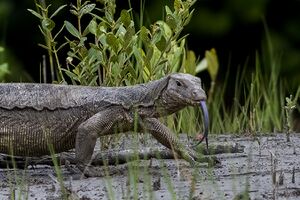
يتم توزيع ورل الماء الآسيوية على نطاق واسع من الهند وبنغلاديش وسريلانكا وميانمار وتايلاند وكمبوديا ولاوس وفيتنام وقوانغشي الصينية ومحافظات هاينان وماليزيا وسنغافورة إلى جزر سوندا سومطرة وجاوة وبالي وبورنيو وسولاوسي. يسكن في المقام الأول الماء العذبة المنخفضة والأراضي الرطبة قليلة الملوحة. تم تسجيل تواجده حتى في ارتفاع 1,800 متر (5,900 قدم).
The Asian water monitor is widely distributed from India, Bangladesh, Sri Lanka, Myanmar and Thailand, Cambodia, Laos, Vietnam, the Chinese Guangxi and Hainan provinces, Malaysia, Singapore to the Sunda islands Sumatra, Java, Bali, Borneo and Sulawesi. It inhabits primarily lowland freshwater and brackish wetlands. It has been recorded up to an elevation of 1,800 m (5,900 ft).[1]
...
The Asian water monitor is semiaquatic and opportunistic; it inhabits a variety of natural habitats though predominantly resides in primary forests and mangrove swamps. It has been noted that it is not deterred from living in areas near human civilization. In fact, it has been known to adapt and thrive in agricultural areas as well as cities with canal systems, such as in Sri Lanka, where they are not hunted or persecuted. Habitats that are considered to be most important are mangrove vegetation, swamps, wetlands, and elevations below 1,000 m (3,300 ft). It does not thrive in habitats with extensive loss of natural vegetation and aquatic resources.[1]
A population of these monitors have become established as an invasive population in the southeastern parts of the USA.[16]
السلوك والبيئة
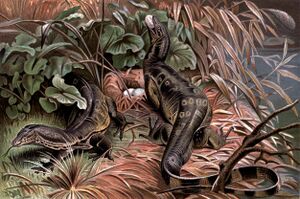
Water monitors defend themselves using their tails, claws, and jaws. They are excellent swimmers, using the raised fin on their tails to steer through water. When encountering smaller prey items, the water monitor will subdue it in its jaws and proceed to violently thrash its neck, destroying the prey's organs and spine which leaves it dead or incapacitated. The lizard will then swallow it whole. In dominantly aquatic habitats, their semiaquatic behavior is considered to provide a measure of safety from predators. This along with their versatile diet is said to contribute to their plasticity, or ecological adaptability.[1] When hunted by predators such as the king cobra (Ophiophagus hannah) they will climb trees using their powerful legs and claws. If this evasion is not enough to escape danger, they have also been known to jump from trees into streams for safety, a tactic similar to that of the green iguana (Iguana iguana).[14]
Like the Komodo dragon, the water monitor will often eat carrion,[2][17] or rotten flesh. By eating this decaying flesh, the lizard provides benefits to the ecosystem by removing infectious elements, cleaning the environment.[18] They have a keen sense of smell and can smell a carcass from far away.
While adults are terrestrial, juveniles are primarily arboreal. [19]
The first description of the water monitor and its behaviour in English literature was made in 1681 by Robert Knox, who observed it during his long confinement in the Kingdom of Kandy: "There is a Creature here called Kobberaguion, resembling an Alligator. The biggest may be five or six feet long, speckled black and white. He lives most upon the Land, but will take the water and dive under it: hath a long blue forked tongue like a sting, which he puts forth and hisseth and gapeth, but doth not bite nor sting, tho the appearance of him would scare those that knew not what he was. He is not afraid of people, but will lie gaping and hissing at them in the way, and will scarce stir out of it. He will come and eat Carrion with the Dogs and Jackals, and will not be scared away by them, but if they come near to bark or snap at him, with his tail, which is long like a whip, he will so slash them, that they will run away and howl."[20]
التكاثر
The Asian water monitor breeds between April and October. The females will lay their eggs about a month after mating in rotting logs or stumps. A clutch can vary from 10 to 40 eggs with an incubation period of 6 to 7 months. When hatched, hatchlings are fully developed and independent. Once males and females reach a length of about 1 meter and 50 centimeters, respectively, they will become reproductively mature and able to breed.[بحاجة لمصدر]
المأكل
They are carnivores, and consume a wide range of prey. They are known to eat fish, frogs, rodents, birds, crabs, and snakes.[2] They have also been known to eat turtles, as well as young crocodiles and crocodile eggs.[21] Water monitors have been observed eating catfish in a fashion similar to a mammalian carnivore, tearing off chunks of meat with their sharp teeth while holding it with their front legs and then separating different parts of the fish for sequential consumption.[22] In Java, they have also been recorded entering caves at night to hunt bats that have fallen from cave's ceiling.[23]
As carnivores and scavengers,[24] the diet of the Asian water monitor in an urban area in central Thailand includes fish, crabs, Malayan snail-eating turtles (Malayemys macrocephala), Chinese edible frogs (Hoplobatrachus rugulosus), birds, small rodents, domestic cats (Felis catus) and dogs (Canis familiaris), chickens (Gallus gallus domesticus), food scraps and carcass.[25] They are known to feed on dead human bodies. While on the one hand their presence can be helpful in locating a missing person in forensic investigations, on the other hand they can inflict further injuries to the corpse, complicating ascertainment of the cause of death.[26] The stomachs of 20 adult Asian water monitors caught on Redang Island contained mostly human food waste, followed by turtle eggs and hatchlings, crabs and lizard eggs.[27] The monitor does not thrive in these areas, but manage to still live in them. Studies are being conducted in order to understand how these creatures are able to do so in and around human civilization.[28]
In Sri Lanka, human corpses are often scavenged on by V. s. salvator, which can make it hard to identify the deceased, or to run autopsies. For instance, the feeding marks made by a monitor's sharp claws resemble wounds made by bladed weapons.[29] In one case however, the presence of eight dead water monitors near the corpse of a partially scavenged 51 year old man prompted investigation that revealed the possibility that the man died from poisoning after ingesting a bottle of Carbosulfan pesticide, which then poisoned the water monitors that scavenged on his body.[30]
السم الزعاف
The possibility of venom in the genus Varanus is widely debated. Previously, venom was thought to be unique to Serpentes (snakes) and Heloderma (venomous lizards). The aftereffects of a Varanus bite were thought to be due to oral bacteria alone, but recent studies have shown venom glands are likely to be present in the mouths of several, if not all, of the species. The venom may be used as a defensive mechanism to fend off predators, to help digest food, to sustain oral hygiene, and possibly to help in capturing and killing prey.[31][32]
في ماليزيا تعطي تطعيمات وعلاج في حالة العض , قد يتطور الجرح لغرغرينا وقطع لعضو إذا لم يعالج بسرعة ..
الافتراس
Adult water monitors have very few predators; with the exception of human hunters, only saltwater crocodiles (Crocodylus porosus) are known to target them.[33]
غير الإنسان, فقط تماسيح المياه المالحة التي تشكل تهديد للورل الأسيوي.
التفاعل مع البشر
When feeling threatened, Water monitors have been known to attack humans and they should be handled with caution. The bite of a water monitor can inflict a severe injury. Still, Water monitors have been successfully domesticated as pets, and their bites are not known to be fatal. Some pet stores carry them, however some owners have complained when over time their lizard grew far larger than had been anticipated. Generally they have little fear of humans, and neither do they tend to be aggressive towards humans, so long as they do not feel threatened.[بحاجة لمصدر]
In 1999, a 7 year old boy in Pahang was attacked and bitten in the leg while bathing, requiring 18 stitches.[34]
المهددات
Monitor lizards are traded globally and are the most common type of lizard to be exported from Southeast Asia, with 8.1 million exported between 1998 and 2007 for the international leather market.[35] Today the majority of the harvesting of feral water monitors occurs in Southeast Asia, in Indonesia, and in peninsular Malaysia.[36] Efforts to breed or farm Water monitors in captivity on a commercial scale have not been widely successful. The Asian water monitor is one of the most exploited varanids; its skin is used for fashion accessories such as shoes, belts and handbags which are shipped globally, with as many as 1.5 million skins traded annually[1] and between 50,000 and 120,000 skins harvested from the wild in peninsular Malaysia.[36] Other uses include a perceived remedy for skin ailments and eczema,[37] novelty food in Indonesia,[38] and a perceived aphrodisiac,[39] and as pets.[40] In India, several tribal communities hunt these monitor lizards for their meat, fat and skin and the eggs are also harvested. They are often considered as pests and their populations are also threatened by habitat loss and habitat fragmentation.[41]
الحفاظ
In Nepal, it is a protected species under the Wild Animals Protection Act of 2002. In Hong Kong, it is a protected species under Wild Animals Protection Ordinance Cap 170. In Malaysia, this species is one of the most common wild animals, with numbers comparable to the population of macaques there. Although many fall victim to humans via roadkill and animal cruelty, they still thrive in most states of Malaysia, especially in the shrubs of the east coast states such as Pahang and Terengganu as the regulations in Malaysian states differ based on wildlife management authorities.[42] In Thailand, all monitor lizards are protected species.[40] It is still common in large urban areas in Thailand and is frequently seen in Bangkok's canals and parks. Because of this, it is currently listed as Least Concern in the IUCN Red List. These classifications have been made on the basis that this species maintains a geographically wide distribution, can be found in a variety of habitats, adapts to habitats disturbed by humans, and is abundant in portions of its range despite large levels of harvesting.[1]
Loss of habitat and hunting has exterminated water monitors from most of mainland India. In other areas they survive despite being hunted, due in part to the fact that larger ones, including large females that breed large numbers of eggs, have tough skins that are not desirable.[43]
In Sri Lanka, it is protected by local people who value its predation of "crabs that would otherwise undermine the banks of rice fields".[43] It is also protected as it eats venomous snakes.[44]
The species is listed in Appendix II of the Convention on International Trade in Endangered Species (CITES) meaning international trade (import/export) in specimens (including parts and derivatives) is regulated.[1]
المراجع
- ^ أ ب ت ث ج ح خ د ذ Quah, E.; Lwin, K.; Cota, M.; Grismer, L.; Neang, T.; Wogan, G.; McGuire, J.; Wang, L.; Rao, D.-Q.; Auliya, M. & Koch, A. (2021). "Varanus salvator". IUCN Red List of Threatened Species. 2021: e.T178214A113138439. doi:10.2305/IUCN.UK.2021-2.RLTS.T178214A113138439.en. Retrieved 29 January 2022.
- ^ أ ب ت Sprackland, R. G. (1992). Giant lizards. Neptune, NJ: T.F.H. Publications. ISBN 978-0-86622-634-9.
- ^ Netherton, J.; Badger, D. P. (2002). Lizards: A Natural History of Some Uncommon Creatures—Extraordinary Chameleons, Iguanas, Geckos, and More. Stillwater, MN: Voyageur Press. pp. 140–141. ISBN 978-0-7603-2579-7.
- ^ Laurenti, J. N. (1768). "XC. Stellio salvator". Specimen Medicum, Exhibens Synopsin Reptilium Emendatam cum Experimentis circa Venena [Medical Treatise, Exhibiting an Emended Synopsis of Reptiles, with Experiments Concerning Venoms and Antidotes for Austrian Reptiles]. Viennae: Joan. Thomae. p. 58.
- ^ Böhme, W. (2003). "Checklist of the living monitor lizards of the world (family Varanidae)". Zoologische Verhandelingen, Leiden. 341: 4–43. Archived from the original on 2017-12-22. Retrieved 2020-05-13.
- ^ Samarasinghe, D. J. S.; Surendran, H.; Koch, A. (2020). "On the taxonomy and distribution of Varanus salvator andamanensis Deraniyagala, 1944 (Reptilia: Varanidae), including a redescription of the type specimens and a discussion about its allopatric co-occurrence with V. s. macromaculatus on the Nicobar Islands". Zootaxa. 4743 (1): 64. doi:10.11646/zootaxa.4743.1.5. PMID 32230352. S2CID 214484186. Archived from the original on 2020-12-22. Retrieved 2020-05-13.
- ^ أ ب ت Koch, A. (2007). "Morphological studies on the systematics of South East Asian Water Monitors (Varanus salvator Complex): Nominotypic populations and taxonomic overview". Mertensiella. 16 (109): e80.
- ^ "Observations • iNaturalist". iNaturalist.org. Retrieved 30 April 2024.
- ^ أ ب ت ث Shine, R.; Harlow, P. S. & Keogh, J. S. (1996). "Commercial harvesting of giant lizards: The biology of water monitors Varanus salvator in southern Sumatra". Biological Conservation. 77 (2–3): 125–134. Bibcode:1996BCons..77..125S. doi:10.1016/0006-3207(96)00008-0.
- ^ Dryden, G. L.; Green, B.; Wikramanayake, E. D. & Dryden, K. G. (1992). "Energy and water turnover in two tropical varanid lizards, Varanus bengalensis and V. salvator". Copeia. 1992 (1): 102–107. doi:10.2307/1446540. JSTOR 1446540.
- ^ Shine, R.; Harlow, P. S. (1998). "Ecological traits of commercially harvested water monitors, Varanus salvator, in northern Sumatra". Wildlife Research. 25 (4): 437−447. doi:10.1071/WR97118.
- ^ Salakij, C.; Salakij, J.; Prihirunkit, K.; Narkkong, N.-A.; Sanyathitiseree, P.; Kranjanapitukkul, K. (2014). "Quantitative and qualitative morphologic, cytochemical, and ultrastructural characteristics of blood cells in captive Asian water monitors". Veterinary Clinical Pathology. 43 (4): 538–546. doi:10.1111/vcp.12183. PMID 25123583.
- ^ "Varanus salvator". World Association of Zoos and Aquariums. Archived from the original on 30 April 2015. Retrieved 22 August 2012.
- ^ أ ب "Asian Water Monitor". Wildlife Facts. Archived from the original on 2019-11-11. Retrieved 2017-12-01.
- ^ "Water Monitor Care Sheet | Black Dragon Care Sheet | Varanus salvator Care Sheet". Vital Exotics (in الإنجليزية). Archived from the original on 2 December 2017. Retrieved 1 December 2017.
- ^ Common Water Monitor (Varanus salvator): Ecological Risk Screening Summary. U.S. Fish & Wildlife Service, February 2022. [1]
- ^ Rahman, K. M. M.; Rakhimov, I. I.; Khan, M. M. H. (2017). "Activity budgets and dietary investigations of Varanus salvator (Reptilia: Varanidae) in Karamjal ecotourism spot of Bangladesh Sundarbans mangrove forest". Basic and Applied Herpetology. 31: 45–56. doi:10.11160/bah.79.
- ^ Chetruengchai, Wanna; Singchat, Worapong; Srichomthong, Chalurmpon; Assawapitaksakul, Adjima; Srikulnath, Kornsorn; Ahmad, Syed Farhan; Phokaew, Chureerat; Shotelersuk, Vorasuk (2022). "Genome of Varanus salvator macromaculatus (Asian Water Monitor) Reveals Adaptations in the Blood Coagulation and Innate Immune System". Frontiers in Ecology and Evolution. Frontiers Media S.A. 10. doi:10.3389/fevo.2022.850817.
- ^ Stanner, Michael (2020). "A Case of Arboreality in an Adult Water Monitor (Varanus salvator macromaculatus)". BIAWAK. 14 (1&2): 56–57.
- ^ Knox, R. (1681). An Historical Relation of the Island of Ceylon in the East Indies: Together With, an Account of the Detaining in Captivity the Author, and Divers, Other Englishmen Now Living There, and of the Author's Miraculous Escape. London: Richard Chiswell.
- ^ Whitaker, R. (1981). "Bangladesh – Monitors and turtles". Hamadryad. 6 (3): 7–9.
- ^ Stanner, M. (2010). "Mammal-like Feeding Behavior of Varanus salvator and its Conservational Implications" (PDF). Biawak. 4 (4): 128–131. Archived (PDF) from the original on 2019-04-23. Retrieved 2012-08-21.
- ^ Clarkson, Myke; Massyn, Devon (2020). "Nocturnal Hunting Activity of Varanus salvator in Goa Lalay Cave, Pelabuhan Ratu, Indonesia". BIAWAK. 14 (1&2): 79–81.
- ^ Chetruengchai, Wanna; Singchat, Worapong; Srichomthong, Chalurmpon; Assawapitaksakul, Adjima; Srikulnath, Kornsorn; Ahmad, Syed Farhan; Phokaew, Chureerat; Shotelersuk, Vorasuk (2022). "Genome of Varanus salvator macromaculatus (Asian Water Monitor) Reveals Adaptations in the Blood Coagulation and Innate Immune System". Frontiers in Ecology and Evolution. Frontiers Media S.A. 10. doi:10.3389/fevo.2022.850817.
- ^ Kulabtong, S. & Mahaprom, R. (2014). "Observation on food items of Asian water monitor, Varanus salvator (Laurenti, 1768) (Squamata Varanidae), in urban eco-system, Central Thailand" (PDF). Biodiversity Journal. 6 (3): 695–698. Archived (PDF) from the original on 2021-05-09. Retrieved 2021-05-02.
- ^ Gunethilake, K. M. T. B.; Vidanapathirana, M. (2016). "Water monitors; Implications in forensic death investigations". Medico-Legal Journal of Sri Lanka. 4 (2): 48–52. doi:10.4038/mljsl.v4i2.7338.
- ^ Rusil, M.U.; Chen, G.N.; Booth, D.T. & Lei, J. (2020). "Diet preference and activity of Asian water monitor at Chagar Hutang Turtle Sanctuary" (PDF). Journal of Sustainability Science and Management. 15 (6): 68–74. doi:10.46754/jssm.2020.08.00 (inactive 31 January 2024). Archived (PDF) from the original on 2 May 2021. Retrieved 2 May 2021.
{{cite journal}}: CS1 maint: DOI inactive as of يناير 2024 (link) - ^ Thanasak, Jitkamol; Roytrakul, Sittiruk; Toniti, Waraphan; Jaresitthikunchai, Janthima; Phaonakrop, Narumon; Thaisakun, Siriwan; Charoenlappanit, Sawanya; Surarit, Rudee; Sirimanapong, Wanna (2023). "The investigation of antibacterial properties of peptides and protein hydrolysates derived from serum of Asian water monitor (Varanus salvator)". PLOS ONE. Public Library of Science. 18 (10): e0292947. doi:10.1371/journal.pone.0292947. PMC 10584125. PMID 37851665.
- ^ Gunawardena, Sameera (2016). "Forensic Significance of Monitor Lizard Scavenging Activity on Human Corpses". BIAWAK. 10 (2): 45–47.
- ^ Mendis, N.D.N.A.; Banda, Y.M.G (2020). "Death Investigation: Does Post-mortem Scavenging by Animals Always Make it Difficult?". BIAWAK. 14 (1&2): 45–49.
- ^ Arbuckle, Kevin (2009). "Ecological Function of Venom in Varanus, with a Compilation of Dietary Records from the Literature" (PDF). Biowak. 3 (2): 46−56. Archived (PDF) from the original on 2018-11-22. Retrieved 2017-08-15.
- ^ Yong, E. (2013). "The Myth of the Komodo Dragon's Dirty Mouth". National Geographic. Archived from the original on 15 August 2017. Retrieved 15 August 2017.
- ^ Ng, M.; Mendyk, R.W. (2012). "Predation of an adult Malaysian Water monitor Varanus salvator macromaculatus by an Estuarine Crocodile Crocodylus porosus" (PDF). Biawak. 6 (1): 34–38. Archived (PDF) from the original on 2020-07-13. Retrieved 2020-04-15.
- ^ de Lisle, Harold (2007). "Varanid Attacks". BIAWAK. 1 (2): 58.
- ^ Nijman, V. (2010). "An overview of international wildlife trade from Southeast Asia". Biodiversity and Conservation. 19 (4): 1101−1114. Bibcode:2010BiCon..19.1101N. doi:10.1007/s10531-009-9758-4. Archived from the original on 2020-12-22. Retrieved 2017-02-02.
- ^ أ ب Khadiejah, Syarifah; Razak, Norazlinda; Ward-Fear, Georgia; Shine, Richard; Natusch, Daniel J. D. (2019-05-08). "Asian water monitors (Varanus salvator) remain common in peninsular Malaysia, despite intense harvesting". Wildlife Research (in الإنجليزية). 46 (3): 265–275. doi:10.1071/WR18166. ISSN 1448-5494.
- ^ Uyeda, L.; Iskandar, E.; Purbatrapsila, A.; Pamungkas, J.; Wirsing, A.; Kyes, R. (2014). "Water Monitor Lizard (Varanus salvator) Satay: A Treatment for Skin Ailments in Muarabinuangeun and Cisiih, Indonesia". Biawak. 8 (1): 35–38. Archived from the original on 2020-12-22. Retrieved 2019-07-08.
- ^ Nijman, V. (2015). "Water Monitor Lizards for Sale as Novelty Food in Java, Indonesia". Biawak. 9 (1): 28−32. Archived from the original on 2020-12-22. Retrieved 2019-03-13.
- ^ Nijman, V. (2016). "Perceptions of Sundanese Men Towards the Consumption of Water Monitor Lizard Meat in West Java, Indonesia". Biawak. 10 (1): 22−25. Archived from the original on 2020-12-22. Retrieved 2017-02-15.
- ^ أ ب Komsorn L. & Kumthorn Thirakhupt (2001). "Species Diversity, Distribution and Proposed Status of Monitor Lizards (Family Varanidae) in Southern Thailand" (PDF). The Natural History Journal of Chulalongkorn University. 1 (1): 39–46. Archived from the original (PDF) on 2016-03-04. Retrieved 2015-01-26.
- ^ Shreya Bhattacharya; Andre Koch (August 2018). "Effects of Traditional Beliefs leading to Conservation of Water Monitor Lizards (Varanus salvator) and threatened Marshlands in West Bengal, India". Herpetological Conservation and Biology. 13 (2): 408–414 – via ResearchGate.
- ^ Khadiejah, S., Abu-Hashim, A.K., Musa, F.H., Abdul-Patah, P., Abdul-Rahman, M.T., Ismail, H.I., Wahab, A., and Razak, N.A. (2020). Management and Trade in Asian Water Monitors (Varnanus salvator) in Peninsular Malaysia. Department of Wildlife and National Parks Peninsular Malaysia (PERHILITAN). 87 pages.
- ^ أ ب Ria Tan (2001). "Mangrove and wetland wildlife at Sungei Buloh Wetlands Reserve: Malayan Water Monitor Lizard". Naturia.per.sg. Archived from the original on 2019-01-05. Retrieved 2015-09-15.
- ^ Wirz, P. (1954). Exorcism and the Art of Healing in Ceylon. Leiden: Brill. p. 238.
للاستزادة
- Das, I. (1988). "New evidence of the occurrence of water monitor (Varanus salvator) in Meghalaya". Journal of the Bombay Natural History Society. 86: 253–255.
- Deraniyagala, P. E. P. (1944). "Four New Races of the Kabaragoya Lizard Varanus salvator". Spolia Zeylanica. 24: 59–62.
- Pandav, B. (1993). "A preliminary survey of the water monitor (Varanus salvator) in Bhitarkanika Wildlife Sanctuary, Orissa". Hamadryad. 18: 49–51.
وصلات خارجية
- CS1 maint: DOI inactive as of يناير 2024
- Short description with empty Wikidata description
- Articles with hatnote templates targeting a nonexistent page
- Missing redirects
- أنواع القائمة الحمراء غير المهددة
- Automatic taxobox cleanup
- Articles containing explicitly cited عربية-language text
- Pages using multiple image with auto scaled images
- Articles with unsourced statements from May 2020
- مقالات ذات عبارات بحاجة لمصادر
- Articles with unsourced statements from June 2024
- Varanus
- زواحف بنگلادش
- زواحف بروناي
- زواحف كمبوديا
- زواحف هونگ كونگ
- زواحف الهند
- زواحف إندونيسيا
- زواحف لاوس
- زواحف ماليزيا
- زواحف ميانمار
- زواحف الفلپين
- زواحف سريلانكا
- زواحف تايلند
- زواحف ڤيتنام
- زواحف بورنيو
- زواحف وصفت في 1768
- Taxa named by Josephus Nicolaus Laurenti
- Articles containing video clips


